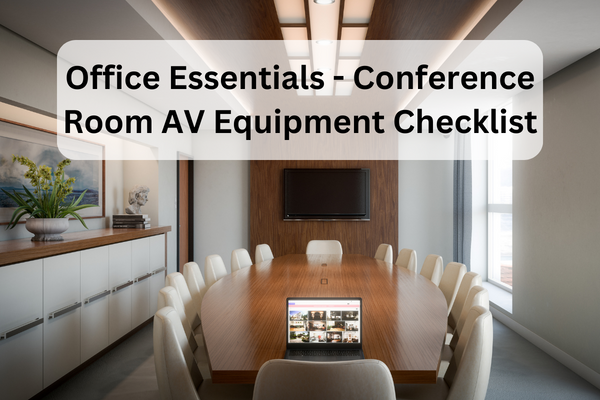Audio-visual (AV) equipment plays a crucial role in modern conference rooms, enhancing communication, collaboration, and the overall meeting experience. From displaying presentations to enabling video conferencing, well-equipped conference rooms are essential for productive and engaging meetings.
Contents
- Significance of a Well-Equipped Conference Room for Productivity
- AV Equipment Checklist: Setting the Foundation
- Integration of Interactive Technologies
- AV Setup Optimization
- Maintenance and Upkeep
- Troubleshooting Common AV Issues in Conference Rooms
- Frequently Asked Questions (FAQs)
- A. What are the essential components of an AV equipment list?
- B. How can I optimize audio quality in a conference room?
- C. Are there wireless connectivity options for conference room setups?
- D. What considerations should be taken for interactive technologies?
- E. How can I troubleshoot common AV issues in my conference room?
- Conclusion
Significance of a Well-Equipped Conference Room for Productivity
A well-equipped conference room is vital for boosting productivity and ensuring that meetings run smoothly. Reliable AV technology and seamless connectivity help prevent technical issues, allowing employees to focus on the meeting’s agenda and discussions. Additionally, a well-equipped conference room supports the needs of both in-person and remote participants, facilitating effective communication and collaboration.
AV Equipment Checklist: Setting the Foundation
Display Devices
Display devices, such as data projectors, screens, and interactive boards, are essential for presenting information and ideas during meetings. When choosing display devices, it’s important to consider the size and resolution that best suit the conference room’s layout and the type of content that will be presented.
Audio Systems
Clear audio is vital for effective communication during business meetings. Selecting suitable microphones and speakers ensures that all participants can hear and be heard, whether they are in the room or joining remotely.
Connectivity Solutions
Cabling and connectivity options, as well as wireless connectivity, are necessary for seamless presentations and easy access to online resources. A reliable internet connection and accessible power outlets are also essential for supporting the use of AV equipment.
Integration of Interactive Technologies
Interactive technologies, such as touchscreen displays and smart control systems, can enhance engagement and streamline the operation of AV devices in conference rooms. These technologies offer practical benefits, such as facilitating interactive presentations and providing user-friendly interfaces for effortless operation.
Touchscreen Displays
Touchscreen displays are interactive devices that allow users to control and interact with content directly on the screen. In a conference room setting, these displays can be used for engaging presentations, collaborative whiteboarding, and easy access to digital content. They enhance the overall meeting experience by enabling seamless interaction with the displayed information.
Smart Control Systems
Smart control systems are central to managing various features of a conference room, including audio-visual equipment, lighting, and environmental settings. These systems provide a user-friendly interface for controlling different devices, allowing for effortless operation and customization of the meeting environment. By integrating smart control systems, conference rooms can be optimized for different meeting scenarios, enhancing convenience and productivity.
AV Setup Optimization
Acoustic considerations and lighting solutions are important for creating an optimal meeting environment. Acoustic treatment helps reduce echoes and enhance sound quality, while smart lighting solutions can improve the overall visibility and presentation quality in the conference room.
Acoustic Considerations
Acoustics play a crucial role in the quality of meetings, as they directly affect communication and productivity. Poorly designed rooms with inadequate acoustic treatments can result in unwanted echoes, reverberation, and background noise, making it difficult for participants to hear and understand each other. On the other hand, a well-designed conference room with effective acoustic solutions can provide numerous advantages:
- Improved speech intelligibility: Proper acoustic treatments ensure clear and intelligible speech, enhancing communication and reducing the need for constant repetition.
- Reduced distractions: By minimizing background noise and echoes, acoustic solutions create a focused environment, allowing participants to concentrate solely on the meeting at hand.
- Enhanced audiovisual experience: With optimal acoustics, audio and visual components work harmoniously, providing a seamless and immersive experience for all attendees
Lighting Solutions
Lighting plays a significant role in the overall quality and visibility of presentations and meetings in a conference room. Proper lighting can enhance the visibility of content, improve the overall presentation experience, and create a comfortable environment for all participants. Here are some lighting solutions to consider:
- General lighting: Ensure that the conference room has adequate general lighting to provide a comfortable and well-lit environment for all attendees.
- Task lighting: Provide task lighting, such as desk lamps or adjustable lighting fixtures, to accommodate individual needs and preferences.
- Projector lighting: Make sure the projector is properly lit and positioned to avoid glare and ensure that the content is visible to all participants.
- Smart lighting: Implement smart lighting solutions that allow attendees to easily adjust the lighting levels and settings to suit their preferences and the specific needs of the meeting.
Maintenance and Upkeep
Regular equipment checks, routine maintenance schedules, and troubleshooting common AV issues are necessary to ensure that the AV setup remains reliable and functional. Proactive maintenance and support help prevent technical disruptions during meetings.
Troubleshooting Common AV Issues in Conference Rooms
Troubleshooting common AV issues in conference rooms is essential for ensuring smooth and productive meetings. Here are some common issues and their solutions:
- No sound or muffled audio: Ensure the volume is turned up and not muted. Check the power and connections of external speakers. Inspect cables for damage and securely plug them into the correct ports. Verify the audio settings on your device and select the correct output source.
- Poor video quality: Double-check all cable connections, ensuring they are snugly fit and secure. For wireless connections, reposition or adjust the antenna to minimize interference. Ensure the video source is compatible with the display device.
- Connectivity issues: Check the Wi-Fi connection and ensure a stable internet connection. For wired connections, double-check all cables and ensure they are properly connected. If using a projector, make sure the projector is properly aligned and focused.
- Audio feedback or echo: Check for open microphones or devices that might pick up and relay sound. Adjust microphone sensitivity levels to minimize echo. If the problem persists, consider using a different microphone or adjusting the room’s acoustics.
- Incompatible file formats: Ensure that the file formats used for presentations and other media are compatible with the display devices and software in the conference room.
- Display issues: Verify that the display settings are properly configured and that the correct input source is selected. If using a projector, make sure the projector is properly aligned and focused
Frequently Asked Questions (FAQs)
A. What are the essential components of an AV equipment list?
Discover the fundamental elements that make up a comprehensive AV equipment list, ensuring nothing is overlooked when setting up your conference room.
B. How can I optimize audio quality in a conference room?
Explore practical tips and best practices for achieving optimal audio quality in your conference room, ensuring clear communication in every meeting.
C. Are there wireless connectivity options for conference room setups?
Delve into the world of wireless connectivity solutions, understanding the benefits and considerations for a seamless and clutter-free conference room experience.
D. What considerations should be taken for interactive technologies?
Learn about the factors to consider when integrating interactive technologies like touchscreen displays, enhancing collaboration and engagement in your meetings.
E. How can I troubleshoot common AV issues in my conference room?
Equip yourself with troubleshooting strategies to address common AV issues swiftly, ensuring minimal disruptions and maintaining the efficiency of your conference room setup.
Conclusion
In conclusion, transforming your conference room into a dynamic hub of collaboration requires careful consideration of AV essentials. From selecting the right display devices and audio systems to embracing interactive technologies, this guide has provided a comprehensive overview of creating an optimal environment for productive meetings.
By addressing these key elements, you’re not just creating a space for meetings but an environment that enhances communication, collaboration, and overall efficiency within your office. And if you’re seeking experts who can help in installation of commercial audio-visual at Dallas, TX, consider leveraging professional services to elevate your setup to the next level. With this checklist, you’re well-equipped to transform your conference room into a hub of seamless, impactful presentations and discussions, setting the stage for success in your professional endeavors.










